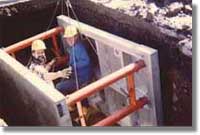|

|
|
GENERAL RECOMMENDATIONS FOR PROJECTS
THAT INCLUDE EARTH MOVING, GRADING,
OR OTHER SOIL OPERATIONS
 The following procedures can be implemented on future
projects as general procedures. They should not supersede specific
recommendations made as a result of a cultural resources evaluation, but should
be implemented as general procedures to be followed when other instructions are
lacking. The term "Agency", when capitalized, means the entity sponsoring the
work under discussion. This may be a public agency, a private company, or any
other sponsoring agency. The following procedures can be implemented on future
projects as general procedures. They should not supersede specific
recommendations made as a result of a cultural resources evaluation, but should
be implemented as general procedures to be followed when other instructions are
lacking. The term "Agency", when capitalized, means the entity sponsoring the
work under discussion. This may be a public agency, a private company, or any
other sponsoring agency.
- It should be required of all contractors and subcontractors that they
inform all employees or others on the job site that no artifacts are to be
removed from the area except through authorized procedures. In this usage
"artifacts" means any item over fifty (50) years of age.
It should be made
clear to all individuals and companies associated with any project that any
artifacts found in the course of work are the property of the Agency. It is
not up to the contractor to determine what the Agency considers important.
When defining artifacts so closely, the district retains the ability to
determine whether or not to bring in an archaeologist to examine the find. As
a general rule, artifacts greater than 100 years of age should be considered
important unless a specific evaluation determines otherwise. Artifacts greater
than fifty years old, but less than 100 years old should be considered
important enough to be evaluated, but generally, the process of recording the
discovery location will be an adequate "mitigation" of any potential negative
impacts. Artifacts less than fifty years old are only important if they
associate with a specific historic event of recognized significance.
- Any artifacts that are found on or near the project area are to
be turned over to, or brought to the attention of, the inspector, project
manager, or the individuals immediate supervisor
. The inspector is the
most likely interface for this task. He or she is on the job daily, and sees
everything that is built. The most workable situation would probably see the
individual workers turning things into their immediate supervisor, who would
report the discovery to the inspector. The inspector should go to the
discovery location and determine that the artifact is not part of a larger
deposit. This may not be obvious. If the inspector is satisfied that other
artifacts will not be found in the location, the artifact should be removed
from the area and work continued. If the inspector cannot make the
determination, an archaeologist should examine the area and make appropriate
recommendations. Often, if a major archaeological site is found, it will be
apparent to all that an important discovery has been made. More subtle
deposits require professional evaluation to determine their importance.
- Whenever any artifact is found or reported, a tag should be included that
indicates the following:
- the identity of the finder and the date of discovery,
- the identity of the inspector or other responsible individual to whom
the artifact is given,
- a description of the location where the artifact was found, such as the
approximate distance and direction to the nearest measured point,
identification of a point on the building plans, or other reliable, accurate
method,
- a description of the artifact that will allow it to be identified if the
tag and artifact are separated.
If the inspector carries a supply of small plastic
baggies and 3x5 cards this process will be very simple. For large artifacts
the tag can be attached with string or tape. Wrapping large artifacts with
survey tape and writing on the tape is acceptable. The important thing is
that the information be kept with the artifact. If the project is going to
involve extensive excavation or ground disturbance, it is more likely that
artifacts will be found. In these instances, preprinted cards can be used
that prompt for the appropriate information.
- The artifact, if portable, should be transported to a safe location where
it can be kept until it can be inspected by an archaeologist
- . When removed
by the inspector or other responsible person, the artifact should be
transported to a location such as the Agency office where it can be kept under
secure conditions. At the beginning of any project, the location for artifacts
to be brought, and the responsible individuals they can be turned over to,
should be identified by the Project Manager. A log of artifacts should be
maintained at the storage location.
If you have questions about whether your project will need professional
monitoring or spot checking, please contact us.
|
